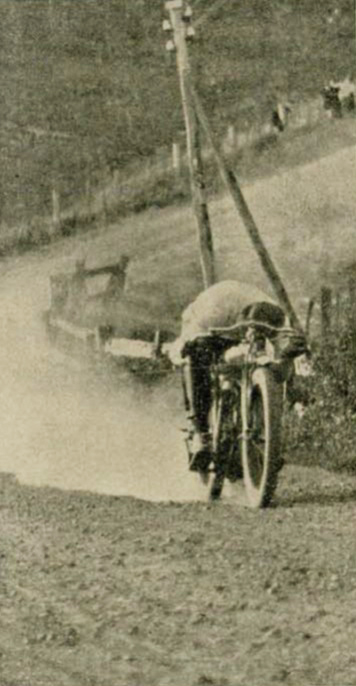Back in 1906, what is now the Hume Freeway heading north out of Melbourne was simply known as Sydney Road – a wide thoroughfare encompassing a narrow strip of rolled and crushed gravel, fearsomely dusty in any breeze, treacherously slippery in the rain and perpetually potholed and corrugated. Hardly the perfect road for a motorcycle race, but for the Victorian Motor Cycle Club it was Hobson’s choice.
A suitable starting point was chosen a few miles north of the city, near the Campbellfield Hotel. From there a distance of 12.5 miles to the north was measured, with the first races being ‘there and back’ for a total of 25 miles. Since the main road could not be closed, a shotgun start was deemed unwise as competitors had to deal with normal traffic – consisting almost exclusively of horse-drawn drays and wagons. Instead, riders were sent out at 30-second intervals.
Although racing on public roads was not an offence, these events were doomed from the beginning. Members of the public were outraged at being roosted by a score of speed demons terrifying the livestock.
Albert Sutton won the inaugural 1906 race on a 3hp Beauchamp, becoming the winner of the first long-distance motorcycle race on the planet.
While the Brits will claim that the first long-distance road race was held over the 16-mile St John’s Short Course on the Isle of Man in 1907 – and the IOM has since created more motorcycling legends than the Hume Highway – but the Victorian road races gained in popularity, at least with competitors. The course was extended to 25 miles and for several years the events ran to 50 and then 100 miles. It was only then that the risks of riders simultaneously heading both north and south on the same narrow strip of rutted hardpack became apparent.
The public, the press and the politicians were up in arms, demanding that the rules of the road be strictly observed and that all necessary precautions be taken to avoid an accident.
Most of these rules (such as a “motorcycle must use the left side of the road when passing any oncoming vehicle, horse or cart”) made sense, road racing or not. But being forced to “come to an immediate halt when signalled by anyone having charge of a horse” was open to interpretation – was that before or after the horse
had bolted?
Curiously, the Victorian Motor Car Act did not prescribe a specific speed limit, though it did create the very fuzzy offence of “furious” riding. If charged, you needed a silver-tongued brief. But many constables were members of the VMCC and turned a blind eye to competitors’ indiscretions. Other than the language, nothing much has changed over the last century.
Obviously the VMCC was more than aware of the dangers to racers and the public sharing the same busy road; though most good burghers avoided the area on race days.
The last race on the Sydney Road was held in 1912. The VMCC attempted a similar set-up on the Bendigo Road in 1913, then moved to the Camperdown Road the following year. But the writing was on the wall after two competitors met head-on in the dusty conditions; both were badly injured and one eventually had his hand amputated.
Victoria’s final open road race was based in Mortlake, west of Melbourne, where a triangulated 84-mile course was plotted on surrounding rural roads. And while the Mortlake circuit was later used for several long-distance endurance rides, 1915 was the last time the public and competitors used the same section of hardpack.
Future road races were held on closed roads, though crowd control continued to be a problem.

By Peter Whitaker











